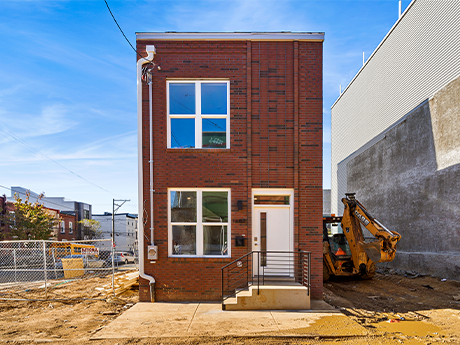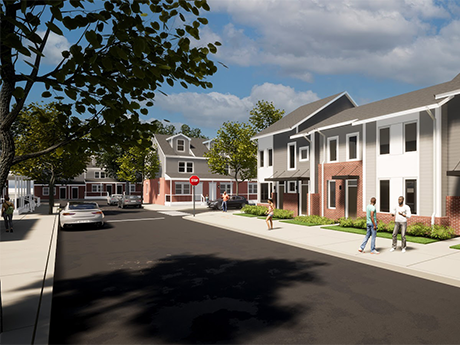Last year, developers in Philadelphia built hundreds of new row houses on vacant, city-owned lots. The houses would sell to new homeowners at affordable prices. Many housing advocates say it’s not nearly enough.
While new, luxury apartments charge record-high rents in neighborhoods around Center City, other streets in Philadelphia are still lined with vacant lots strewn with trash.
As rents rise across the city, Philadelphia’s new mayor, Cherelle Parker, has promised to produce 30,000 new units of affordable housing over four years. That’s more than 8,000 units of housing per year.

To meet that goal, she is calling on the Philadelphia Land Bank — the repository for vacant and abandoned land owned by the city — to provide more sites for all types of affordable housing at nominal cost to developers.
So far, leading developers of affordable housing are enthusiastic about the plan.
“The effort this current administration is putting into the Land Bank is absolutely tremendous,” says Milton Pratt, executive vice president of Camden, New Jersey-based Michaels Development. Building new affordable rental housing can help Philadelphia prevent more low-income households from being priced out of their neighborhoods.
“When the neighborhood improves, building and preserving affordable housing is the way that you’re able to keep families who have been there over the years,” he says.
Philly Still Full of Vacant Lots
There were 42,100 vacant properties in Philadelphia as of 2019, according to the most recent comprehensive count from the Land Bank. These lots are scars left by nearly 50 years of urban decline. North of Center City, there are still a handful of blocks where vacant lots outnumber the few old row houses left standing.
The population of Philadelphia shrank from a high of 2 million in 1950 to a low of 1.5 million in 2000, with the biggest losses in the 1970s and 1980s, according to the U.S. Census Bureau.
Philadelphia began to grow again in the new millennium, adding a few thousand people by 2010, though the population still rounded to 1.5 million. Many thousands more joined the population of Philadelphia by 2020, growing the population to 1.6 million.
In 2009, a coalition of neighborhood groups including the Women’s Community Revitalization Project (WCRP) counted the vacant lots in Kensington and Fishtown, neighborhoods just northeast of Philadelphia’s Center City. Back then, one in four addresses was either vacant land or an uninhabited building. Of those vacant sites, a quarter were already publicly owned.
Today, the edge of this community includes some of the most expensive apartments in Philadelphia, such as Piazza Alta, a new, luxury apartment tower developed by locally based Post Brothers
A decade ago, city officials created the Land Bank to collect city-owned vacant and abandoned lots into a single portfolio and offer them to new owners planning to return them to productive use, including developers of affordable housing.
For years, the program provided land to build an average of fewer than 100 units of housing a year. It was much more successful in fiscal year (FY) 2022, when it provided land for about 200 new units of housing.
Then in FY 2023, Philadelphia’s Land Bank provided 412 vacant, city-owned sites to new owners, according to the Land Management Dashboard, an informational website run by Philadelphia’s Department of Planning and Development (DPD). That’s the most activity the agency has ever recorded in a single year.
Those sites largely went to developers with plans to build 371 new units of housing, mostly in the shape of newly constructed and affordably priced for-sale row houses. The hundreds of sites returned to productive use also include new gardens, expansion space for businesses and vacant lots claimed as side yards by their neighbors.
The set of developers who are building these affordable row houses say that they are just getting started.
“We’ve built well over 100 homes, and we have 110 more in our pipeline,” says Max Frankel, principal with Philadelphia-based Frankel Enterprises.
Hundreds of New Houses Built
Turn the Key (TTK), the Philadelphia Affordable Homeownership Program, has released a wave of new developments, including Frankel Enterprises’ new row houses at Blumberg Sharswood in North Philadelphia. In September, Frankel completed the last phase of the 73-unit project. The Land Bank sold the land for the development to Frankel at a nominal cost.
TTK provides developers land to build single-family houses that sell at prices no higher than $280,000 each. All of the row houses in the program are priced to be affordable to moderate income homebuyers who earn less than 120 percent of the area median income.
The city also provides financial assistance to low-income families to help cover mortgage and closing costs. The Turn the Key program is part of the $400 million Neighborhood Preservation Initiative approved by the Philadelphia City Council in April 2022.
The Land Bank also continues to provide development sites to developers such as Michaels to build rental housing affordable for low-income households. But Turn the Key has been the land bank’s main focus in recent years.
“We prioritize giving working-class families the opportunity to create generational wealth and become homeowners,” says Jamila Davis, spokesperson for the Philadelphia Housing Development Corp. and Department of Planning and Development.
The new activity is not nearly enough for critics of Philadelphia’s Land Bank. They say the group is understaffed and needs to become more transparent, accountable and efficient. Every transfer of land made by the Land Bank needs to be approved by the city council, which may slow down or stop some applications.
“We have a Land Bank, but much work remains to make it the Land Bank our communities demanded and deserve,” according to an April 2024 letter to City Hall from city council members and housing advocates including Local Initiative Support Corp. Philadelphia.
Forty percent of households in Philadelphia are burdened by the high housing costs, meaning they pay more than 30 percent of their income on housing, according to the city’s analysis of 2022 data from the U.S. Census Bureau.
Fight to Preserve a Mixed-Income Neighborhood
The cost of housing is rising faster than incomes in the Sharswood neighborhood of North Philadelphia, for example. That’s a problem Michaels’ Executive Vice President of Development Milton Pratt never expected to see in his lifetime.
“We’ve been working in the Sharswood neighborhood for probably 30 years,” says Pratt. “The neighborhood is experiencing a tremendous inflow of higher income families.”
The year, Michaels will open dozens of new affordable apartments at its Harlan Sharswood development. The new building is across the street from 71 recently renovated apartments at the Sharswood Townhouses, which Michaels originally built in 2000 near the site of the Norman Blumberg Apartments.
The public housing site was once notorious for drug crimes and broken elevators. The site is now being redeveloped by the housing authority and partners through the federal Neighborhood Choice Program.
Michaels built Harlan Sharswood on a collection of vacant lots, half of which the developer already owned. Michaels received the other half from city entities including the Land Bank and the Philadelphia Housing Authority.
“This project could not have happened without the Philadelphia Housing Authority and the city investing heavily in acquiring land, holding it and then providing it to developers,” says Pratt. That’s because the cost of developable land has risen quickly.
“There’s so much real estate speculation in these neighborhoods that are improving,” says Pratt. “You see very modern, three-story townhouses right next to vacant lots, but you know the vacant lots are not going to be vacant for very long.”
Market-rate developers are now willing to pay relatively high prices for land on which they can build. “There are speculators that have held lots for 15 years and now they’re selling them off to developers,” says Pratt.
Despite the rising cost of land, higher housing costs also make some parts of developing affordable housing easier. Banks are more willing to make loans to developers in neighborhoods where properties have proven value. Homeowners in these neighborhoods have also benefited from rising home values.
About 15 years ago, Michaels also built 151 homes for sale on vacant land that sold for approximately $99,000 each at the time. “Those homes are now probably worth an estimated $350,000,” says Pratt.
Today, Michaels is no longer fighting to save a blighted neighborhood that is losing population. Sharswood is now a neighborhood that is home to people earning a mix of incomes. Michaels is now fighting to preserve that mix of incomes by creating more affordable housing.
“The families in the neighborhood that just happen to be low-income deserve to be there,” says Pratt. “They’ve been there through the years when Philadelphia was losing population. We want to be the kind of developer that supports these families staying.”
Mayor Parker’s Grand Plan
Philadelphia’s new mayor is also focused on developing new affordable housing. Parker was inaugurated in January 2024 with a plan to create 30,000 new units of affordable housing in just four years — and that will likely require a much more active Land Bank.
In April, Mayor Parker appointed five new members to the Land Bank’s board, including Majeedah Rashid, chief operating officer of Nicetown CDC, a developer of affordable rental housing, typically subsidized by low-income housing tax credits (LIHTC).
There should be more than enough vacant land to go around. There are still tens of thousands of vacant lots scattered through Philadelphia, though the last full accounting is still the count of 42,000 vacant properties from 2019. The Land Bank had 4,800 city-owned properties that were available for sale in mid-2024, according to DPD’s Dashboard.
“Philadelphia still has a plethora of vacant land,” says Frankel. “Certain neighborhoods have a dearth of public land inventory, but certainly not all neighborhoods.”
Turn the Key Promotes Homeownership
BVG Property Group, based in Bala Cynwyd, Penn acquired 27 sites from the Land Bank in 2023. These sites were scattered through neighborhoods of South Philadelphia and Port Richmond. The developer built 27 row houses, including 20 homes for sale at affordable prices through the Turn the Key program.

The buyers of these Turn the Key homes also received a $75,000 second mortgage that will be forgiven if they hold the property 15 years. To qualify for the program, homebuyers must earn no more than 120 percent of the area median income.
First-time homebuyers are also eligible for another $10,000 in grants to help pay closing costs.
Homebuyers typically take out a conventional home mortgage to cover the rest of the cost. So far, more than a dozen banks have worked with the program.
“From a banking perspective, to be honest, it’s a win for them,” says Justin Veasey, co-founder of BVG. That’s because the appraisable value of the home is already greater than the loan amount.
Building new townhouses on these vacant lots has an immediate effect on what people are willing to pay to live nearby or whether they’re willing to live there at all.
“The vacant lots were problematic because of drug use and trash storage,” says BVG’s Veasey. “We also encountered a lot of problems at first because the site had been vacant for so long that the soil was bad and had to be trucked away.”
Fixing these problems immediately improved the property values around them.
The Turn the Key homes sell for a maximum price of $280,000, though the price can be lower in neighborhoods still struggling with blight or vacant property. BVG’s row houses in South Philadelphia on South 30th Street sold for $274,000 and row houses in Port Richmond sold for $264,000.

“There are market-rate homes across the street that have sold for $375,000,” says Veasey.
More often than not, these vacant lots don’t have anything on them that needs to be removed, other than trash. “Sometimes it’s a parking lot but usually it’s just dirt,” says Brennan Tomasetti, co-founder of Civetta Property Group, based in Philadelphia.
“At our ribbon cuttings, we’ve had homeowners come out and say, ‘Thank you so much for infilling this lot. It’s been a source of crime.’”
So far, Civetta has sold 63 homes through Turn the Key. It is currently building another 80 homes in the Brewerytown neighborhood.
Homebuyers receive an average of eight hours of free housing counseling through the Turn the Key program.
“The population for whom these homes are intended don’t even often have home ownership on their mind,” says Tomasetti. “They’re programmed to think that it’s not possible.”
Civetta has been working with the land bank to educate prospective homebuyers.
“This truly can be attainable with limited funds down and less of a monthly payment than you’re paying in rent,” says Tomasetti. “Our average buyer is between $40,000 and $60,000 a year in household income.”
Beyond the Land Bank
Other developers of affordable rental housing are finding new ways to acquire land on which to build.
WCRP recently spent $500,000 to buy a site in southwest Philadelphia to build 33 new affordable apartments at the Linda Lockman King Apartments.
The developer recently launched a loan fund to help it buy properties like this site, raising more than $2 million from wealthy donors and foundations over the past three years.
The new, four-story Linda Lockman King Apartments will include supportive housing for very low-income families at risk of becoming homeless.
“We’ve raised the money to buy land because the land bank doesn’t have enough land left for the kind of development that we do,” says Nora Lichtash, executive director of Philadelphia-based WCRP.
The developer has a long history of working with Philadelphia officials to build on land owned by the city. In July 2024, WCRP opened 27 new apartments for low-income households at its Arlene Thorpe Townhomes on land provided by the Land Bank in Philadelphia’s Grays Ferry neighborhood.
But those sites are becoming more and more difficult to find.
Most of the vacant lots in the Land Bank are about the size of a single row house. It is increasingly difficult to find a group of these lots that can be merged into a single site for one new apartment building. Generally, developments need to be at least 24 units in size to be successfully financed through the federal LIHTC program.
“I’ve been doing this for 38 years. I never thought there would not be enough land,” says Lichtash. She remains committed to finding sites to produce more affordable rental housing so that low-income households will be able to stay in their neighborhoods as housing costs increase.
“There are all the things that rich neighborhoods get that you want every neighborhood to have,” says Lichtash. “The schools are better. The police start coming. Before, you used to call the police, and they would never come. The trash gets picked up more often.”
The cost of housing also grows.
“There’s a million benefits to having a safe, strong neighborhood,” says Lichtash. “But you just want to be able to stay in that neighborhood.”
— Bendix Anderson


